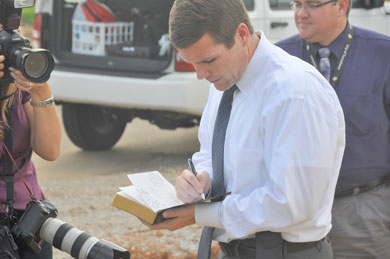2012 Municipal Leader of the Year: Building a championship team
Leadership shines beyond disaster
Leadership shines beyond disaster
But the accolades for Maddox extend beyond his leadership during the tornado crisis. Robert Witt, who is the Chancellor of the University of Alabama system and was previously president of the University of Alabama in Tuscaloosa, considered Maddox’s work following the tornado as exemplary but also extols him for the partnership that the two of them were able to develop between the city and the university.
Since the mayor won office, he says, he has built a rapport between the property owners around the university and the students, maintained a strong relationship between the city and university police departments and has made a special effort to accommodate the massive influx of over 100,000 revelers who come watch the Crimson Tide on Game Day.
Students have adopted a positive attitude toward the mayor, he says. “Part of it is that he is a relatively young man,” he says about Maddox, who is 39. “He’s youthful and connects well with young people. He’s become a visible presence on campus. The students say, ‘He’s our mayor.’ He’s perceived as part of the University of Alabama.”
Maddox’s youthful appearance is not an accident. A four-year letterman at the University of Alabama-Birmingham, where he was a defensive tackle, he continues to stay fit by running at least one marathon a year. He graduated wanting to be a college football coach, but as things worked out, he became the field director for the Alabama Educator’s Association, executive director of personnel in the Tuscaloosa City Schools and a City Councilman in 2001 before winning election for mayor in 2005 and re-election in 2009.
“I’ve truly enjoyed being mayor,” he says. “It’s an opportunity to effect change.”
 Maddox says that when he took office he announced five core beliefs, ranging from better pre-K, public safety and economic development to better customer service and improvements in impoverished areas. When he learned that FEMA disaster relief training was available, he pursued it because it fit nicely into his program. But he didn’t expect that it would ever be put to the severe test brought on by the 2011 tornado. Yet, the city was ready, he says.
Maddox says that when he took office he announced five core beliefs, ranging from better pre-K, public safety and economic development to better customer service and improvements in impoverished areas. When he learned that FEMA disaster relief training was available, he pursued it because it fit nicely into his program. But he didn’t expect that it would ever be put to the severe test brought on by the 2011 tornado. Yet, the city was ready, he says.
“The Incident Command center became the sun of our solar system,” he recalls. “Normally, there are 17 department heads to manage. The Incident Command provides the filter, becomes the mechanism to identify problems, create operational teams and see that the problems are solved.”
One example he cites was the loss of water pressure in large parts of the city while gas leaks ignited small fires and the main hospital struggled without water. The Incident Command center identified that before the leaks could be fixed, the debris needed to be cleared. So, the city organized a huge part of its resources to debris removal, and within 48 hours, the water system was restored.

















I wish I could say this was
I wish I could say this was true for all tornado victims!!!!! I think I lot of us got pushed to side to focus on the news worthy story!! I still would like to know how so many victims that I talk too says they turned to city for help only to receive lies and the run around.. But the news has no mention of these victims only the stories that make it seem like they did such a wonderful job helping victims!!!! Haha I know first hand what the city of tuscaloosa thinks about SOME of its citizens!!!